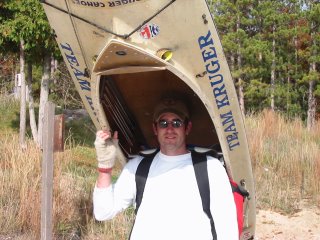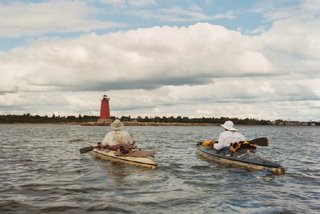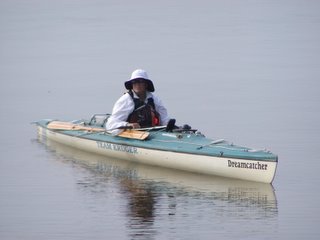Obviously with the WaterTribe Challenges upon us, my timing was pretty bad. The article will be published later this Spring. Below are excerpted paragraphs from the introduction and ending sections of the article, just a teaser, you'll really have to read the full article to appreciate how I have become "Krugarized".
When I arrived in Tampa Bay for my first WaterTribe Everglades Challenge (March 2004), I was an admitted sea kayak snob. You know the type, "you’re not a real sea kayaker unless your boat is longer than 16 ft, British, fiberglass, skeged, and you aspire to climb the BCU star system in paddling". I had read a recommendation from Chief (head of Watertribe) to use kayaks with rudders in the Challenges; I figured I'd show him, if you really know how to sea kayak you don't need a rudder. ...
...I had finished my Challenge with a new perspective and regard for different boaters and boat types. All of us finishing this challenge had accomplished an incredible feat in small boat expeditioning that certainly didn't require a "real sea kayak", and in fact "real sea kayaks" were not necessarily the boats that excelled. Most surprising, at the end of the challenge, I found myself wanting to try out and paddle one of the Krugers. I had finished the challenge having spent 8 days being cold and wet, exhausted, sore, blistered, and chaffed. I even had to sleep (sitting up) in my boat one night. Looking around, I noticed that those paddling Krugers were talking about being comfortable and dry, and fairly pain free after 300 miles...
...Mark Przedwojewski (Watertribe member ManitouCruiser), met and began learning about canoe expedition from the famous Verlen Kruger in
 1995. Mark bought his first Kruger that year, and subsequently began building Kruger Canoes nder Verlen's tutelage. In 2003, Verlen offered Mark the opportunity to purchase the company as he retired. See www.krugercanoes.com for more information on Mark, the Kruger boats, and Verlen. These days, Mark is dedicated to continuing Verlen's work and to making a little part of Verlen's legacy accessible to paddlers...
1995. Mark bought his first Kruger that year, and subsequently began building Kruger Canoes nder Verlen's tutelage. In 2003, Verlen offered Mark the opportunity to purchase the company as he retired. See www.krugercanoes.com for more information on Mark, the Kruger boats, and Verlen. These days, Mark is dedicated to continuing Verlen's work and to making a little part of Verlen's legacy accessible to paddlers... ...Mark had generously offered to loan me his Dreamcatcher, a sea kayak-like Kruger canoe to use in the WaterTribe Ultimate Florida Challenge (UFC), a 1200-mile circumnavigation of Florida including a 40-mile portage, March 4 - April 3, 2006. Mark knew I had wanted to try and do this larger race and that I had concerns about attempting it in my own sea kayak. The offer was a wonderful surprise (not unlike Mark himself), and one I couldn’t refuse. Mark will also be participating in this challenge in a Kruger Sea Wind. Mark has always had a good showing in WaterTribe Challenges, and, has the current distinction of having earned more WaterTribe shark and alligator teeth, (the award received after a successful completion of a WaterTribe Challenge) than any other WaterTribe member...

...The Kruger canoes look different to a sea kayaker and the Dreamcatcher even more so. The boats are advertised as the “ultimate tripping canoes”, designed for comfort, efficiency, and seaworthiness. The Dreamcatcher, looking sort-of like a very big sea kayak, is not a high-performance yak. She is considered
 a traveler, designed for the comfort and stability that would be enjoyed on long distance trips, though many use their Krugers for short day trips. She is not a surfer, nor a play boat, though surf landings and launchings
a traveler, designed for the comfort and stability that would be enjoyed on long distance trips, though many use their Krugers for short day trips. She is not a surfer, nor a play boat, though surf landings and launchingsare often required of her. She doesn't have the extreme maneuverability one would want playing in rock gardens, though her layers of Kevlar make her strong and sturdy in a rocky environment. Through Verlen, and now Mark, her reputation is for long distance expedition travel on water, just what I love the most...
...I had a thousand questions for Mark regarding the performance of the Dreamcatcher (and Kruger’s in general), all of course related to my sea kayaking background. Can she b
 e rolled? How does she handle in surf? How do you brace into waves when broached? How maneuverable is she without the rudder? What about rescues with no front bulkhead? How dry is the back hatch? How will I carry her around getting on and off the beach? Can I use a double bladed paddle? What is faster, single or double blade? Mark patiently tried to answer my questions based on his knowledge and experiences and on Verlen’s and others reported experiences. But he agreed that in the end, I would just have to take her through some paces and see for myself, and, he would be very interested to hear of my results. His confidence in these boats is unwavering, and I could tell he expected I’d feel nothing less...
e rolled? How does she handle in surf? How do you brace into waves when broached? How maneuverable is she without the rudder? What about rescues with no front bulkhead? How dry is the back hatch? How will I carry her around getting on and off the beach? Can I use a double bladed paddle? What is faster, single or double blade? Mark patiently tried to answer my questions based on his knowledge and experiences and on Verlen’s and others reported experiences. But he agreed that in the end, I would just have to take her through some paces and see for myself, and, he would be very interested to hear of my results. His confidence in these boats is unwavering, and I could tell he expected I’d feel nothing less... ...Since returning home, the Dreamcatcher and I have paddled many miles weekly on the lake and have taken a few weekend beach trips. I've not m
 issed paddling my Explorer at all, and have retired it for the season at least until after the challenge. I now think of the Explorer as my play kayak, rather than my expedition kayak. I've also not been much interested in using the GP or any double bladed paddle. Zaveral Racing Equipment has sponsored me in the UC by providing an 8oz bent shaft carbon fiber distance canoe paddle. I find it so much easier on my joints, and enjoy the rest provided by alternating sides. I will need to do some training with a double blade paddle for the UC, as it will be necessary in a rescue situation, and possibly for added stability in rougher water and surf landings. But the single blade has now become my primary paddle...
issed paddling my Explorer at all, and have retired it for the season at least until after the challenge. I now think of the Explorer as my play kayak, rather than my expedition kayak. I've also not been much interested in using the GP or any double bladed paddle. Zaveral Racing Equipment has sponsored me in the UC by providing an 8oz bent shaft carbon fiber distance canoe paddle. I find it so much easier on my joints, and enjoy the rest provided by alternating sides. I will need to do some training with a double blade paddle for the UC, as it will be necessary in a rescue situation, and possibly for added stability in rougher water and surf landings. But the single blade has now become my primary paddle......I've found myself completely surprised at how much I enjoy and love paddling this boat, though I still don't quite know what to call it, a canoe or a kayak. It doesn't really look like a canoe, and you don't kneel in it. It's rather large for a sea kayak, does not quite maneuver
like a sea kayak, and has so much buoyancy it sort of bobs on top of the water, yet it does look more kayak than canoe. That I paddle it with a canoe paddle makes it difficult for me to call it a kayak, though certainly there is a tradition even in more traditional Inuit kayaking cultures of using a single blade paddle with kayaks. Needing to classify what I do, and not really able to
classify the boat to my liking, I've taken to just saying "I'm a paddler".
Six months later, I still love paddling this boat, and believe it truly is the perfect boat for me to attempt this huge Challenge in. But more than that, I intend to eventually own a Kruger Canoe for all my future trips and expeditions. I can't imagine doing one in anything else now.



3 comments:
To me a Kruger is easy to classify. It is a kayak. The whitewater folks have this all figured out. If you can only sit, it is a kayak. If you can kneel or sit it is a canoe.
They often take a kayak and convert it to a canoe by removing the seat and adding a kneeling saddle.
Canoes or kayaks can have decks or be pretty open. My old pungo and the pamilco's are pretty open, and many canoes have decks.
You can paddle either one with any kind of paddle, single blade, double blade, pole, or even your hands.
Still to me it is as simple as determining if you can kneel in it. If you can kneel while paddling , then it must be some kind of canoe.
I hear that in Britain, they think kayaks are a subset of canoes. So I guess that would mean they are all canoes. Then, I would still ask what makes some canoes a kayak.
These boats look a lot like hardshell versions of the Longhaul and Klepper folding kayaks - do they cost as much, or more?
What's the advantage of having a hardshell versus a folder in this type of boat? Seems the folder has the advantage in ease of transportation and storage, at least before or after put in and take out.
Just my dos centavos.
frank I think that is an oversimplification.
Mark Molina - several times National Men's FreeStyle Canoe champion and also won the International Kayak Rolling championship in Iceland a coupls of years ago - once commented that he wasn't sure what the difference was, because as soon as you named a defining feature, he could name an exception. If an international champion in both canoe and kayak disciplines isn't sure what the difference is between Kayak and Canoe, then I don't feel too inadequate about my inability to define them either.
I own a WeNoNah Advantage - definitely a canoe, but also a sit-down marathon style boat. I also own a Sea Wind and I am often asked whether it is a Kayak or a Canoe. I dunno - but Verlen Kruger called it a canoe so I guess to me it is a canoe. Doesn't really matter - whatever it is it paddles GREAT!
Post a Comment